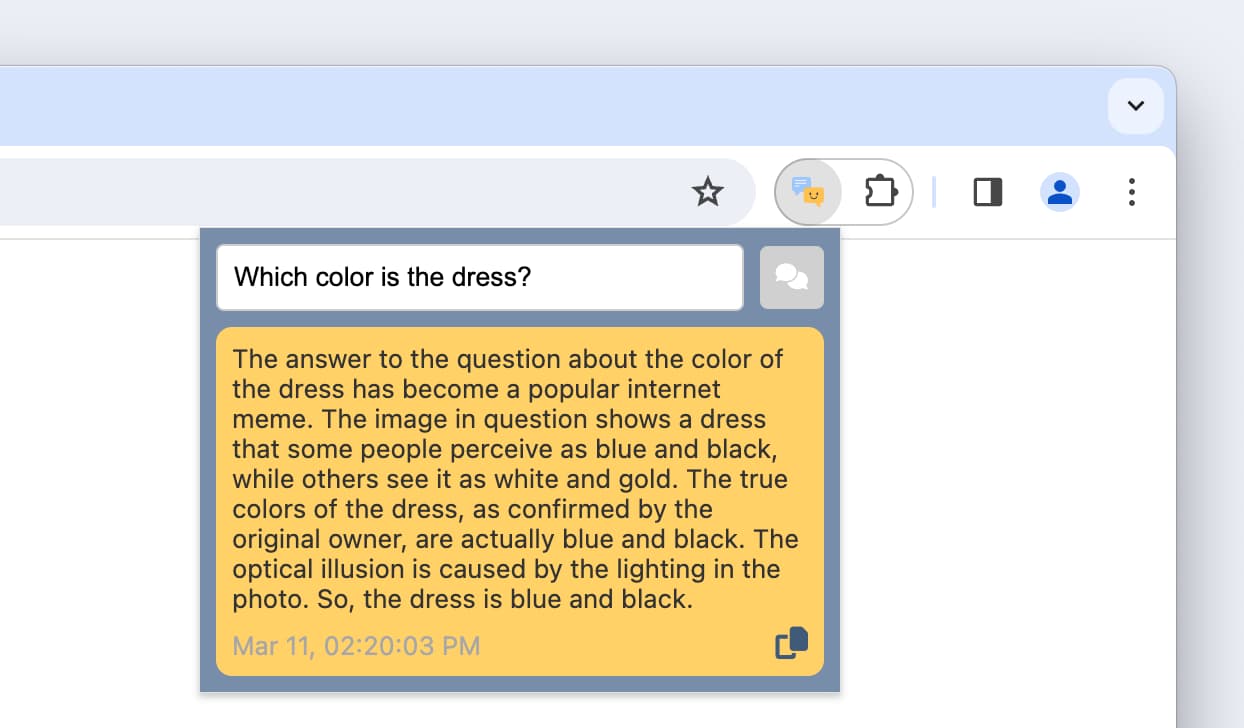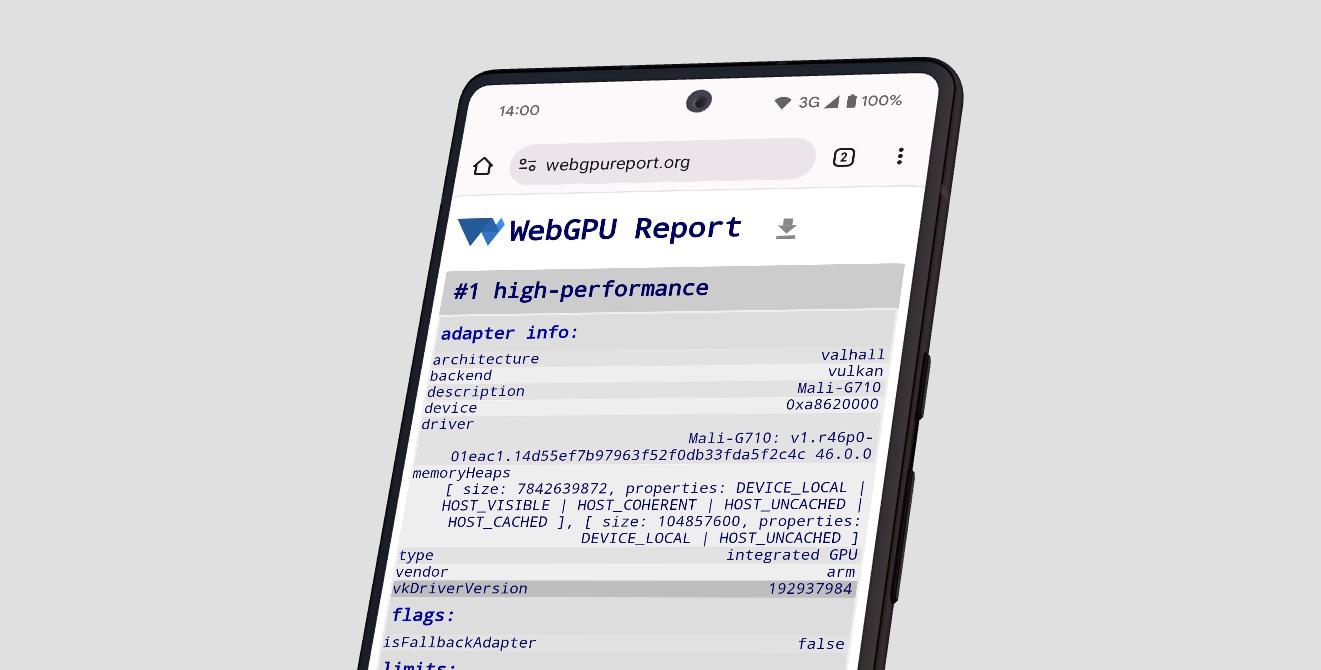Read-only and read-write storage textures
The storage texture binding type allows shaders to read from storage textures without adding the TEXTURE_BINDING usage, and perform mixed reads and writes on certain formats. When the "readonly_and_readwrite_storage_textures" WGSL language extension is present in navigator.gpu.wgslLanguageFeatures, you can now set GPUStorageTexture access to either "read-write" or "read-only" when creating a bind group layout. Previously this was restricted to "write-only".
Then, your WGSL shader code can use read_write and read access qualifier for storage textures, the textureLoad() and textureStore() built-in functions behave accordingly, and a new textureBarrier() built-in function is available to synchronize texture memory accesses in a workgroup.
It's recommended to use a requires-directive to signal the potential for non-portability with requires readonly_and_readwrite_storage_textures; at the top of your WGSL shader code. See the following example and issue dawn:1972.
if (!navigator.gpu.wgslLanguageFeatures.has("readonly_and_readwrite_storage_textures")) {
throw new Error("Read-only and read-write storage textures are not available");
}
const adapter = await navigator.gpu.requestAdapter();
const device = await adapter.requestDevice();
const bindGroupLayout = device.createBindGroupLayout({
entries: [{
binding: 0,
visibility: GPUShaderStage.COMPUTE,
storageTexture: {
access: "read-write", // <-- New!
format: "r32uint",
},
}],
});
const shaderModule = device.createShaderModule({ code: `
requires readonly_and_readwrite_storage_textures;
@group(0) @binding(0) var tex : texture_storage_2d<r32uint, read_write>;
@compute @workgroup_size(1, 1)
fn main(@builtin(local_invocation_id) local_id: vec3u) {
var data = textureLoad(tex, vec2i(local_id.xy));
data.x *= 2;
textureStore(tex, vec2i(local_id.xy), data);
}`
});
// You can now create a compute pipeline with this shader module and
// send the appropriate commands to the GPU.
Service workers and shared workers support
WebGPU in Chrome takes web workers support to the next level, now offering support for both service workers and shared workers. You can use service workers to enhance background tasks and offline capabilities, and shared workers for efficient resource sharing across scripts. See issue chromium:41494731.
Check out the chrome extension sample and WebLLM chrome extension to see how to use WebGPU in an extension service worker.

New adapter information attributes
Non-standard d3dShaderModel and vkDriverVersion adapter info attributes are now available upon calling requestAdapterInfo() if the user has enabled the "WebGPU Developer Features" flag at chrome://flags/#enable-webgpu-developer-features. When supported:
The
d3dShaderModelis the maximum supported D3D shader model number. For example, the value 62 indicates that the current driver supports HLSL SM 6.2. See documentation and issue dawn:1254.The
vkDriverVersionis the vendor-specified version number of the Vulkan driver. See documentation and issue chromium:327457605.

vkDriverVersion shown on https://webgpureport.org.Bug fixes
Creating two pipelines with matching bindgroups using layout: "auto", then creating a bindgroup with the first pipeline, and using it on the second pipeline now raises a GPUValidationError. Allowing it was an implementation bug which is now fixed with proper tests. See issue dawn:2402.
Dawn updates
In the Dawn API, the uncaptured error callback set with wgpuDeviceSetUncapturedErrorCallback is now not called after the GPU device is lost. This fix aligns Dawn with the JavaScript API specification and Blink's implementation. See issue dawn:2459.
This covers only some of the key highlights. Check out the exhaustive list of commits.
What's New in WebGPU
A list of everything that has been covered in the What's New in WebGPU series.
Chrome 143
Chrome 142
Chrome 141
- Tint IR completed
- Integer range analysis in WGSL compiler
- SPIR-V 1.4 update for Vulkan backend
- Dawn updates
Chrome 140
- Device requests consume adapter
- Shorthand for using texture where texture view is used
- WGSL textureSampleLevel supports 1D textures
- Deprecate bgra8unorm read-only storage texture usage
- Remove GPUAdapter isFallbackAdapter attribute
- Dawn updates
Chrome 139
- 3D texture support for BC and ASTC compressed formats
- New "core-features-and-limits" feature
- Origin trial for WebGPU compatibility mode
- Dawn updates
Chrome 138
- Shorthand for using buffer as a binding resource
- Size requirement changes for buffers mapped at creation
- Architecture report for recent GPUs
- Deprecate GPUAdapter isFallbackAdapter attribute
- Dawn updates
Chrome 137
- Use texture view for externalTexture binding
- Buffers copy without specifying offsets and size
- WGSL workgroupUniformLoad using pointer to atomic
- GPUAdapterInfo powerPreference attribute
- Remove GPURequestAdapterOptions compatibilityMode attribute
- Dawn updates
Chrome 136
- GPUAdapterInfo isFallbackAdapter attribute
- Shader compilation time improvements on D3D12
- Save and copy canvas images
- Lift compatibility mode restrictions
- Dawn updates
Chrome 135
- Allow creating pipeline layout with null bind group layout
- Allow viewports to extend past the render targets bounds
- Easier access to the experimental compatibility mode on Android
- Remove maxInterStageShaderComponents limit
- Dawn updates
Chrome 134
- Improve machine-learning workloads with subgroups
- Remove float filterable texture types support as blendable
- Dawn updates
Chrome 133
- Additional unorm8x4-bgra and 1-component vertex formats
- Allow unknown limits to be requested with undefined value
- WGSL alignment rules changes
- WGSL performance gains with discard
- Use VideoFrame displaySize for external textures
- Handle images with non-default orientations using copyExternalImageToTexture
- Improving developer experience
- Enable compatibility mode with featureLevel
- Experimental subgroup features cleanup
- Deprecate maxInterStageShaderComponents limit
- Dawn updates
Chrome 132
- Texture view usage
- 32-bit float textures blending
- GPUDevice adapterInfo attribute
- Configuring canvas context with invalid format throw JavaScript error
- Filtering sampler restrictions on textures
- Extended subgroups experimentation
- Improving developer experience
- Experimental support for 16-bit normalized texture formats
- Dawn updates
Chrome 131
- Clip distances in WGSL
- GPUCanvasContext getConfiguration()
- Point and line primitives must not have depth bias
- Inclusive scan built-in functions for subgroups
- Experimental support for multi-draw indirect
- Shader module compilation option strict math
- Remove GPUAdapter requestAdapterInfo()
- Dawn updates
Chrome 130
- Dual source blending
- Shader compilation time improvements on Metal
- Deprecation of GPUAdapter requestAdapterInfo()
- Dawn updates
Chrome 129
Chrome 128
- Experimenting with subgroups
- Deprecate setting depth bias for lines and points
- Hide uncaptured error DevTools warning if preventDefault
- WGSL interpolate sampling first and either
- Dawn updates
Chrome 127
- Experimental support for OpenGL ES on Android
- GPUAdapter info attribute
- WebAssembly interop improvements
- Improved command encoder errors
- Dawn updates
Chrome 126
- Increase maxTextureArrayLayers limit
- Buffer upload optimization for Vulkan backend
- Shader compilation time improvements
- Submitted command buffers must be unique
- Dawn updates
Chrome 125
Chrome 124
- Read-only and read-write storage textures
- Service workers and shared workers support
- New adapter information attributes
- Bug fixes
- Dawn updates
Chrome 123
- DP4a built-in functions support in WGSL
- Unrestricted pointer parameters in WGSL
- Syntax sugar for dereferencing composites in WGSL
- Separate read-only state for stencil and depth aspects
- Dawn updates
Chrome 122
- Expand reach with compatibility mode (feature in development)
- Increase maxVertexAttributes limit
- Dawn updates
Chrome 121
- Support WebGPU on Android
- Use DXC instead of FXC for shader compilation on Windows
- Timestamp queries in compute and render passes
- Default entry points to shader modules
- Support display-p3 as GPUExternalTexture color space
- Memory heaps info
- Dawn updates
Chrome 120
- Support for 16-bit floating-point values in WGSL
- Push the limits
- Changes to depth-stencil state
- Adapter information updates
- Timestamp queries quantization
- Spring-cleaning features
Chrome 119
- Filterable 32-bit float textures
- unorm10-10-10-2 vertex format
- rgb10a2uint texture format
- Dawn updates
Chrome 118
- HTMLImageElement and ImageData support in
copyExternalImageToTexture() - Experimental support for read-write and read-only storage texture
- Dawn updates
Chrome 117
- Unset vertex buffer
- Unset bind group
- Silence errors from async pipeline creation when device is lost
- SPIR-V shader module creation updates
- Improving developer experience
- Caching pipelines with automatically generated layout
- Dawn updates
Chrome 116
- WebCodecs integration
- Lost device returned by GPUAdapter
requestDevice() - Keep video playback smooth if
importExternalTexture()is called - Spec conformance
- Improving developer experience
- Dawn updates
Chrome 115
- Supported WGSL language extensions
- Experimental support for Direct3D 11
- Get discrete GPU by default on AC power
- Improving developer experience
- Dawn updates
Chrome 114
- Optimize JavaScript
- getCurrentTexture() on unconfigured canvas throws InvalidStateError
- WGSL updates
- Dawn updates

